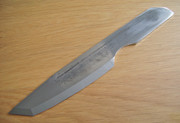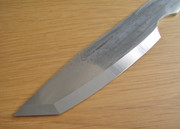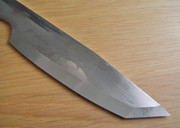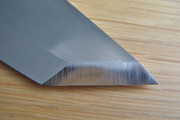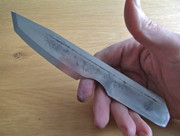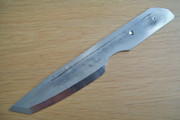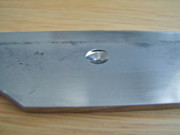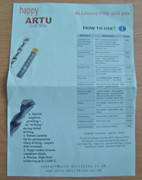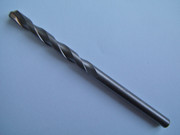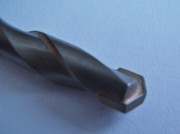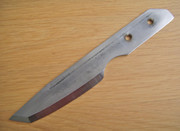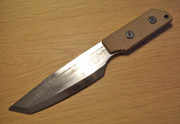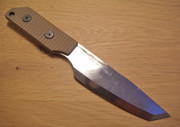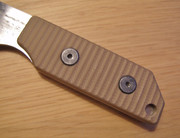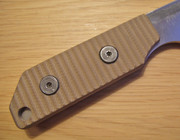Currently busy making a knife out of a old piece of Sandvik M2 high speed steel machine saw (about 65-66 HRC) with the help of my Tormek T7 wet grinder.
Since i had a couple of old G10 grips from a Strider DB-L the overall shape was an easy choice, but in the process i added a little belly to the edge.
The main edge measures 22.5 degrees with a mini-bevel, while the slanted portion measures 25 degrees inclusive with a zero edge.
Full hard M2 high speed steel knife
-
-
Next step is to try to drill the holes for the G-10 grips with these speciality drills:
-
Hallo kwakster,
Danke für die Präsentation und den Video-Link. Bin schon auf Deine nächsten Schritte gespannt.
Gruss
suomi70
-
The 6 mm Artu drill bits arrived, so it was time to try them on the M2 steel.
The instruction paper said that when the drill bits are to be used on hardened steel to use a drill press with 2000 r.p.m, but since i don't own one (yet) i just tried one in a hand held drill.
I put the knife in a vise with a piece of wood behind it and started drilling; the deeper "dent" is the result of about 15 minutes drilling it this way.As you can see i still didn't get through, but the Artu drill bit still did many times better than an average (re-sharpened) masonry drill bit that only managed to make a shiny spot on the M2 steel and go blunt right away in the process.
Seen with the naked eye the Artu drill bit shows no signs of blunting whatsoever.
I'm going to tinker with this drill bit some more in the coming days (and maybe look around for a reasonably priced drill press) -
Maybe try a full carbide drill. Choose the hardest grade you can acquire. Drilling hardened high speed tool steel is one tough job.... You should definitely get a drill press to maintain the needed cutting force.
Great work so far!
-
i agree with Stefan, a good special drill, together with a drill press and some propper cooling during the drillprocess will be sucessfull, i think.
-
Job done with the help of the Artu drill bit and the drill press of a very helpful Dutch knifemaker.
The process worked exactly as i was told by an Australian knifemaker with experience in using these Artu's: at first nothing seem to happen until the material warms up a bit, then suddenly the drill bit starts to produce a nice blue burr and drills the hole in a few seconds.
Afterwards we inspected the drill bit itself, and except for some discoloration of the shaft it was completely unaffected.The pics:
At first the grip screws didn't fit the holes exactly, but after i enlarged one of the holes with the help of a Dremel & a diamond cutter they did.
Then i shortened the screws (the M2 blade is of course much thinner than the original S30V Strider blade), put on the G-10 grips, and removed the "meat" around the grips for a good fit.
(except for the finger choil where i kept that little extra steel, since M2 isn't known for it's toughness according to the specs)Both the long edge and the short edge now have a mini-bevel finished up to 6 micron diamond compound.
In the coming weeks i hope to find out how the edge holds up. -
Remember the tip of the Artus drill is brazed in thge shaft, with cooling during the drilling you can prevent the brass of becoming loose------
Nice finished knife....

-
Cooling does not work quite well for high speed cutting, a certain temperature is required to get the process started. Don't cool when you cut any hardened steel with appropriate carbide tools.
Kwakster, do you know someone at a machining shop? Get someone with a surface grinder for a nice and smooth finish of the flats. If you want to, I can do this for you.
-
Thanks for the offer Stefan, it's appreciated, but i'm not sure yet if i want to go that way.
With 2,5 mm thickness the knife is already quite thin and i want to preserve as much metal as i can.This M2 knife is meant as an experimenting piece: first to find out if i could cold grind the bevels with my Tormek, and second to see what kind of edge this steel will take & hold while performing a variety of jobs.
Once i get to know it's limits as a pure cutter my plan is to make a few more knives in this steel, and i'm currently thinking of puukko's with a zero edge geometry that would be as thin as possible but still thick enough to take full advantage of the high hardness and it's wear resistance.BTW: the holes were drilled by Dutch knife maker Dirk de Wit in his machine shop with a Flott drill press, and Dirk already stated that he would help out if i needed something else done to this knife or another.
-
A follow-up took some time, but here it is.
After some cutting tests with this M2 knife i arrived at a measured edge angle between 22.5 and 25 degrees inclusive, as this seems to be right at the balance point between as thin as possible, yet thick enough.
This edge survives multiple full force cuts into my wooden testblock (a piece of laminated desktop) without chipping or noticeable loss of sharpness.
Afterwards the knife could also still pushcut through this paperback.
-
Jetzt mitmachen!
Sie haben noch kein Benutzerkonto auf unserer Seite? Registrieren Sie sich kostenlos und nehmen Sie an unserer Community teil!

